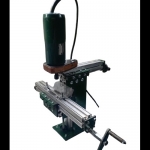Scratch built table top mini mill made from common materials. Simple to construct without the complications of specialised tooling being needed. It is possible to make and assemble this machine using only basic hand tools and a drilling machine.
- 1 meter (3.2 Feet) or less of Aluminium Profile
- A single 300x300 MM sheet of Material is sufficient for the entire build
- The flat and square bar seen was used for convenience. The parts could arguably be derived from the same material as the machine sides
- Tapped holes are not strictly necessary
- Base plate is salvaged mild steel 130MMx120MMx8MM
Took about 6 hours to put together. Quite a fun little build and the machine capabilities blew me away a bit, wasn't expecting much but am now impressed after some tests. The aluminium extrusion is 35x35 MM with 6 MM T Slots, I recon PG40x40 Heavy will work as well (10 MM T Slot).
The sheet of clear plastic is a chip guard that slots into the table.
Three views with Rotary Tool Spindle fitted
The Z axis is a bolt and brass nut combo. The knee is drilled about 80% through to accommodate the screw.
Close Up Milling Action.
Tested climb milling, plunging and slot milling without any drama. One notable issue is the lack of machine dampening, although rigid with little to no chatter. from what I can tell, at higher spindle speeds vibrations tend to wiggle things loose.
6 MM 2 Flute Carbide Cutter (Straight Flute) in cast iron plus micro milling with 3 MM HSS dovetail cutter
Cutting parameters: 0.4 - 4 MM depth of cut. 18000-25000 RPM @ 100-200 MM/MIN full cutter width
The threaded holes are for set screws and would be used to level the gibb and remove slop. The holes should have been drilled closer to the operator (offset from the through hole axis'). I had to use thick shims without set screws to achieve the desired results.
To avoid drilling into faces of the extrusion I opted to run an M5 rod through the centre and bolt the ram guide block and base plate together through the column. I tested the unit without this rod and it works just fine. Obviously the tool ends up less ridged but it didn't seem terrible.
Metal-on-metal contact is avoided by using book biding cover plastic cut outs with slits cut in them to trap oil. These cut outs are sandwiched between sliding surfaces.
This same plastic is also used as shim stock when required. I'm sure its not the best all round material but it certainly does the trick and costs pennies a sheet at any stationary shop. I may also like to try gasket paper perhaps.
All faces of the aluminium extrusions were honed to remove burs and other surface defects.
Low-tech table alignment. A flex shaft spindle tommy bar is colleted and the long end swept over four points on the table. First the table is made perpendicular to the spindle at the front side. The table guide block has two bolts connected to the knee. the upper bolt is the pivot point and the lower to lock it. Both bolts are torqued when the the wiper gap is equal across both points. The ram is traversed back and the distances checked as pictured to ensure parallelism with the table (if not, the machine is reassembled with special care given to making the column and ram block meet at 90 degrees) the table 'level' is then checked a second time from the back.
Would love to hear any thoughts and suggestions thanks,
Cheers.



 LinkBack URL
LinkBack URL About LinkBacks
About LinkBacks































 Reply With Quote
Reply With Quote





Bookmarks